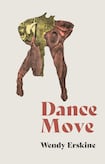
Dance like nobody’s watching, they say, though we hope someone might be looking. This is the tension that Wendy Erskine explores in her exhilarating second book of stories, Dance Move – the different ways in which we express our private selves to the world.
Nothing idles in these 11 stories. The language is only to propel the narrative, bringing to life a vivacious sweep of characters with great economy and making her stories “page turners” of sorts, tales of adventure about the human spirit. Where some authors leave their handprints all over a plot, Erskine’s hold of the story is so delicate her characters are set free – to act as best as they know how, just as the spotlight falls on them.
Early on in the story Cell, the main character, Caro, remembers a teenage disco, that it had been: “astounding how other people could move so fluidly; how they were able to discern a beat which she couldn’t hear”. Her flaw comes to be writ larger in the fabric of the story – unable to perform the complex dance of love and openness and vulnerability, Caro’s social unease leads her astray from herself, and into the hands of others.
Roberta, in the story Mathematics, is another simple soul, her narration like a failing torch in the darkness, compelling the reader to peer forward. She cleans houses after Airbnb parties, the embodiment of our single-use lifestyle, though she is allowed to keep what she finds, “remnants of other people’s fun”. Work is all she knows until she finds an abandoned girl in one house and decides to keep her.
The tension is eerie and muted; as she struggles to hide the girl, her distant understanding of the world simplifies the story to the driving bassline of fairytale.
The turn of events in the story, as in all of Erskine’s stories, is ingenious; her tender, unshowy sentences lead us through the full spectrum of tragedy and comedy. In His Mother, after her son Curtis’s body is found, Sonya goes around with paint scraper, cloth and bottle of soapy water, taking down the missing posters strewn all over the city, so painfully numerous having been put up with such enthusiasm by all the boys from his football club.
In Memento Mori, Gillian’s partner, Tracey, is slowly dying from cancer. But this has to co-exist with the killing of a teenager in front of their house and the shrine and mourners who come with it. Like a charge between two poles, Erskine traces the frictions between the two deaths; the tragedy, frustration and great irony of people oblivious to others’ inner lives.
In the title story – one of the most powerful in the book – Kate disapproves of her teenage daughter’s provocative dancing; she prefers to watch videos of ballet repeatedly. However, it is when she is given the opportunity to dance that Kate finds herself caught between her will to express herself and her urge to suppress.
The collection looks at our great tonguetiedness, what we talk about when we don't talk about love
Drew, in Nostalgie, is a minor 1980s singer who agrees to reprise his songs for a private gig, although his apprehensions about performing have to be recalibrated when he understands it is a paramilitary audience which has adopted his song. This echoes an earlier mismatch – as the story begins, Drew remembers a karaoke night in Cyprus and one holidaymaker who had sung so beautifully it had shocked him: “Drew realised he’d been holding his breath. His eyes were wet. He saw the woman afterwards, loading deckchairs and other beach paraphernalia into the boot of her car.” In the frictionless double view of the woman, we see our own incongruities, , and the things we do that - for better or worse - make us who we are.
In the rich variety of characters, their mistakes and misalignments, we feel the dazzle of MacNeice’s “drunkenness of things being various”. And yet, although their feet seem free to fall where they will, through her great intimacy and subtlety, the design of Erskine’s stories reveals the pattern of a dance.
The collection looks at our great tonguetiedness, what we talk about when we don’t talk about love. Although, reading Erskine’s stories, we understand how such immaculate expression of ourselves can create a moment of grace in the middle of all our flailing.










